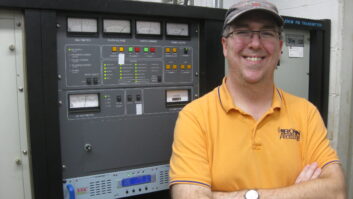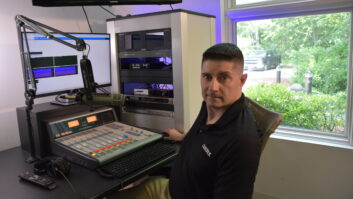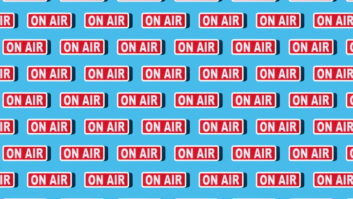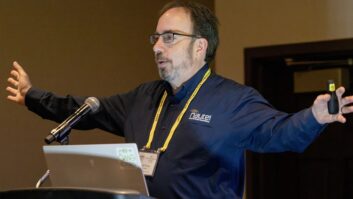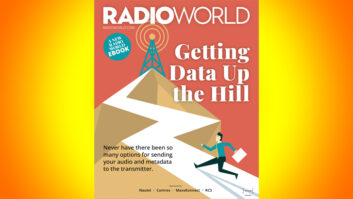WASHINGTON — Terrestrial broadcasters have greater access to microwave spectrum to use as the final radio frequency links in their program distribution chains, now that the FCC has adopted updates to Part 101 of its rules.
The changes, adopted late last year, give broadcasters flexibility in planning STL frequency strategies and more bandwidth for data connectivity projects, according to proponents.
The so-called “final mile” rule was considered by broadcasters to be outdated; it prohibited the use of Part 101 frequencies as the final RF link to the transmitter in programming distribution. The elimination of that rule should benefit stations, especially those in urban areas with highly congested Broadcast Auxiliary Service spectrum, which is licensed under Part 74.

Sample path profile, courtesy J. Moody & Associates
Meanwhile, under the Part 101 changes, non-broadcast users do gain some access to BAS and Cable Antenna Relay Service frequencies in the 6875–7125 MHz and 12700–13100 MHz bands, according to the FCC.
Part 101, or Fixed Microwave Services, already was used by radio stations for telemetry control and satellite backhaul in some cases. Observers contacted by Radio World agreed the “final link” rule was overly prohibitive, considering that most broadcasters need bandwidth to support their modern operations.
The preference of broadcasters to keep their digital audio program feeds linear or uncompressed moved the issue forward, one said. Currently most digitized audio is bitrate-reduced so more channels can fit into a 950 STL RF channel and the smaller landline pipelines.
“The old rules were grounded in an era that predated data connectivity. As the technology has evolved, the rules have not met the demands of that evolution,” said Jim Moody, president of J. Moody and Associates, a broadcast engineering consulting firm.
More bandwidth
The upside for radio broadcasters is access to more bandwidth, a requirement for today’s multiple station cluster environments and HD Radio, Moody said. Often, broadcasters are affected by congestion within the Part 74 frequency allocations. In many cases frequencies within the 950 MHz part of the spectrum are clogged to the point where no options exist, he said. “Broadcasters often have tremendous data bandwidth requirements with RF point-to-point, multiplexed connectivity.”
There are thousands of Private Operational Fixed Service frequencies, but the major bands are in 900 MHz and 2, 2.5, 4, 6, 11, 18 and 23 GHz, Moody said.
The FCC had granted waivers to the final link rule through the years. But that process could take a long time, cost lots of money and offer no guarantee of a favorable outcome, said Moody. He helped several clients with waiver requests that included asking the FCC for Special Temporary Authority to use Part 101 frequencies as the final STL programming link.
Greater Media and Pappas Broadcasting were among broadcasters who received waivers. Greater Media operated its Part 101 links for its Boston station cluster of under STA for several years until it received a permanent waiver in 2009.
“The original spectrum rules, meant to protect broadcasters, essentially limited them in the sense that the bandwidth available in Part 74 no longer met the needs of today’s broadcasters,” Moody said. “Under the old rules, radio broadcasters were eligible for and expected to use Part 74. A prohibition excluded the use of Part 101 as the final link of RF connectivity for circuits carrying programming content.”
Radio broadcasters have been searching for possible solutions for high-bandwidth studio-to-transmitter connectivity problems for years. More modern data connections, such as T1, DS3 (Digital Signal) and OC3 (Optical Carrier), had not been contemplated when the FCC drafted rules that govern STL connectivity.
A T1 line, a high-speed digital connection, is capable of transmitting data at a rate of approximately 1.5 Megabits per second, while an OC3 conveys 155 Mbps. DS3 conveys 45 Mbps.
The FCC originally set up Part 74 decades ago in an “analog world when there was plenty of space and frequencies,” said Larry Miller, a communications attorney with Schwartz Woods & Miller.
“Greater operational flexibility for broadcasters in urban areas has been a growing issue. Part 74 frequencies in urban areas have mostly been exhausted. Part 74 frequencies, which are allotted in 25 kHz portions, are really no longer capable of moving the data needed for multiple station and HD Radio applications.”
Higher throughput
Congestion and interference in the 2.4, 5.3 and 5.8 GHz ISM unlicensed bands have made them almost unusable to broadcasters in urban areas, most observers said.
(click thumbnail)
Greater Media Boston’s 11 GHz network microwave network employs dynamic WAN routing and L3 switching. There are a total of five stations split between two sites, plus five auxiliary facilities at a third location. Image courtesy Greater Media

Miller, who worked with Greater Media on its Part 101 waiver in Boston, said he has had clients already re-purpose their BAS spectrum at no additional cost using equipment already on hand by moving the final link of their programming from studio to transmitter into their existing Part 101 systems.
“This is a big deal for broadcasters,” Miller said.
Corporate directors of engineering for several major broadcast groups concurred with Miller as they prepare to redraw STL plans and paths.
Milford Smith, vice president of radio engineering for Greater Media, said broadcasters need more throughput for both main analog and digital channels of multiple co-sited stations.
Broadcasters also need more throughput for multiple multicast channels, PAD and other program-related data, Advanced Application Services (AAS) data, Ethernet network extensions to various sites, satellite return audio from various downlinks as well as video from a remote camera, Smith said.
Greater Media ultimately was successful in obtaining licenses for a number of Part 101 systems in Boston comprising a so-called Synchronous Optical Network link interconnecting all of their facilities. The broadcaster has several additional applications pending and anticipates filing several more.
Support for the aforementioned bandwidth without the use of expensive leased telco data circuits would have been impossible. “In our case, to equal the throughput of the licensed Part 101 links would require use of something beyond DS3; likely an optical carrier circuit, probably an OC3, at huge expense,” Smith said.
Mike Cooney, vice president of engineering for Beasley Broadcast Group, said the broadcaster has filed Part 101 applications for all of the group’s large market signals.
“This change ensures a reliable connection to the transmitter site for HD multicast and data channels, as well as remote controls, phone lines and security monitoring,” Cooney said.
While Internet connection could provide such services “those options are unavailable to many remote or mountain sites,” he said.
Dane Ericksen of Hammett & Edison Consulting Engineers said broadcasters wishing to use Part 101 for their final STL link will need to file a Prior Coordination Notice, the protocol for frequency coordinating both fixed and mobile microwave paths, when applying for a new 900 MHz band facility in the fixed service.
Commercial microwave frequency coordinators such as Comsearch and Micronet typically charge $800 per path for a PCN, according to Ericksen.
“There will be time and money involved. Probably $1,800 to $2,000 for the consulting services, which would include the PCN fee but not the filing fee.” The FCC filing fee is $150 for a link for a commercial radio or TV station, while such filing fees for links for noncoms are waived, according to Ericksen.
Is your organization responding to the change in Part 101 rules? Tell us how. Write to [email protected].

